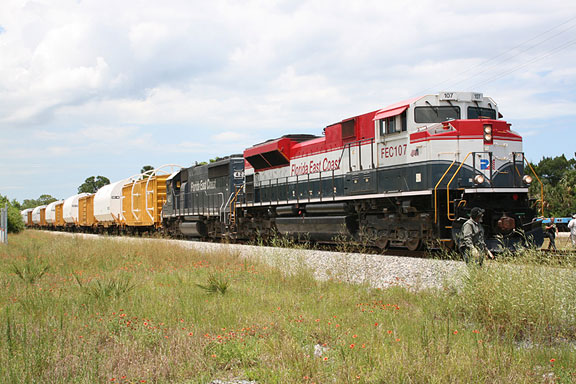The US standard railroad gauge (distance between the rails) is 4 feet, 8.5 inches. That’s an exceedingly odd number. Why was that gauge used?

Because that’s the way they built them in England, and English expatriates built the US Railroads.
Why did the English build them like that? Because the first rail lines were built by the same people who built the pre-railroad tramways, and that’s the gauge they used.
Why did “they” use that gauge then? Because the people who built the tramways used the same jigs and tools that they used for building wagons, which used that wheel spacing.
Okay! Why did the wagons have that particular odd wheel spacing?
Well, if they tried to use any other spacing, the wagon wheels would break on some of the old, long distance roads in England, because that’s the spacing of the wheel ruts.
So who built those old rutted roads? Imperial Rome built the first long distance roads in Europe (and England) for their legions. The roads have been used ever since.
And the ruts in the roads? Roman war chariots formed the initial ruts, which everyone else had to match for fear of destroying their wagon wheels. Since the chariots were made for Imperial Rome, they were all alike in the matter of wheel spacing.
The United States standard railroad gauge of 4 feet, 8.5 inches is derived from the original specifications for! an Imperial Roman war chariot. And bureaucracies live forever
So the next time you are handed a spec and told we have always done it that way and wonder what horse’s ass came up with that, you may be exactly right, because the Imperial Roman war chariots were made just wide enough to accommodate the back ends of two war horses.
Now the twist to the story…
When you see a Space Shuttle sitting on its launch pad, there are two big booster rockets attached to the sides of the main fuel tank. These are solid rocket boosters, or SRBs. The SRBs are made by Thiokol at their factory in Utah. The engineers who designed the SRBs would have preferred to make them a bit fatter, but the SRBs had to be shipped by train from the factory to the launch site.
The railroad line from the factory happens to run through a tunnel in the mountains. The SRBs had to fit through that tunnel. The tunnel is slightly wider than the railroad track, and the railroad track, as you now know, is bout as wide as two horses’ behinds.
So, a major Space Shuttle design feature of what is arguably the world’s most advanced transportation system was determined over two thousand years ago by the width of a horse’s ass.
And you thought being a horse’s ass wasn’t important.









Check it on snopes
Great link Alex! But after all, this is a website dedicated to humor, so u should read this as a joke!
A very well written and funny take on an old story. That is more than can be said for the po-faced article in the link, which seemed to be as much at pains for some reason to downplay the link of the current American standard gauge to the Old World as to “correct” the story. In the end it doesn’t correct the story very much, because the heritage is there for all to see, not perhaps in a direct “A lead to B lead to C” way but in the general thrust of history. Anyway this is getting a little… Read more »
Apologies to Snopes for calling them Stopes! But they are still party poopers.
The detail may be wrong but there is certainly truth in it. Although the Romans never used war chariots, they certainly used lots of supply wagons, which had the axles spaced at around the same as in the early age of steam, or even today (war chariots in Roman times were used most famously by the British tribes under Queen Boudicca, who the legions slaughtered in the Battle of Watling Street). Btw, a Roman Legionary baggage train was called (in Latin) an “impedimenta”. From which we get the English word impediment.
Actually, this isn’t correct. I actually wrote a paper on this, you can access it here:
https://docs.google.com/document/d/1RPHr_PKVR71TygEsXhOFju0ILpfKB84RXNuX9XWYpuY/edit
Feel free to check the sources if you want.
Love that Florida East Coast SD70ACe!!!!!! sweet! might be a SD70M-2 but they look so much alike with the same cab and body
You are right about 4′ 8 1/2″ but wrong about the history. Measurement goes back to the distance of chariot wheels in ancient Rome.
But why were Roman war chariots’ wheels 4 feet, 8.5 inches apart? A cart axle pulled by two horses in harness was about 1.4m or 4ft 8 in long.
This article and its readers comments are a Gas!